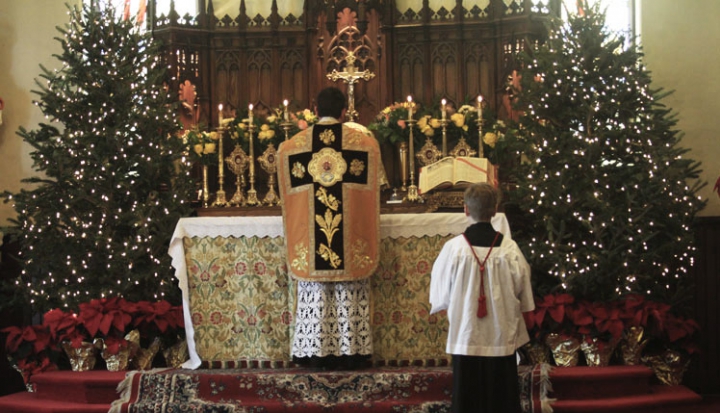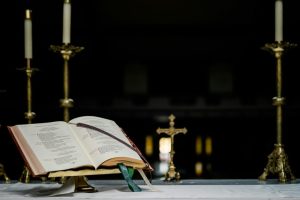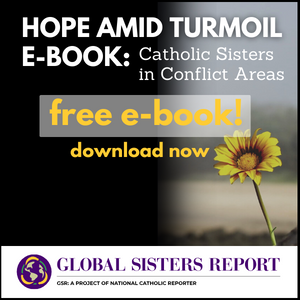For many Catholics, the word liturgy brings to mind processionals with incense and a crucifix, Eucharistic prayers, or the Communion Rite. Vestments, incense, and music may be floating around in our mental pictures as well. But what about other kinds of faith practices? Eucharistic adoration or devotions to patron saints? The blessing of the animals on the feast of St. Francis or the celebration of Our Lady of Guadalupe? Are these celebrations also liturgical? Or are they merely popular reflections of our faith based on each parish’s individual nationality and culture?
Viatorian Father Mark Francis says that it’s not so easy to differentiate between the two. Even the liturgy we assume is universal and unchanging—like the Roman Rite that we follow each time we go to Mass—originated with popular practices during the Roman Empire. Liturgy, a Greek word, means “the work of the people”; it’s the community coming together to celebrate the presence of God among us.
Catholics around the world may worship using the same rubrics, Francis says, but each culture and each congregation adapt the liturgy to reflect their own needs. “If you celebrate the Roman Rite exactly as it is written without being attentive to the people with whom you’re celebrating,” he says, “then you’re not celebrating liturgy; you’re celebrating archaeology.”
There’s no time that this diversity and the living nature of liturgy is more apparent than at Christmas. Las Posadas, Simbang Gabi, Advent wreaths, and the feast of Our Lady of Guadalupe are all examples of popular traditions that have been integrated into the liturgical celebrations of Advent and Christmas.
What’s the difference between popular religion and official liturgy?
Popular religious custom is essentially that which is not considered official or mandatory. Sometimes these are folk customs, sometimes other rites. As the Roman Rite developed, the official rite became increasingly separated from the people. You had the priest located way up in the sanctuary doing his thing in Latin with other clerics up there.
People went to Mass, but they couldn’t follow it. They couldn’t hear it; most of the prayers were said silently or very softly. All the clerical types up at the altar were doing all the actions. So what did people do, especially those who weren’t literate? They came, they prayed the rosary, they did other kinds of devotions. Even today, if you go to Italy you can sit in Mass and someone will be walking up the aisle on her knees to a statue, and no one thinks anything of it.
These devotional practices and other things developed because people weren’t integrally involved in liturgical actions. Popular religious custom then, in a certain sense, takes place outside of official liturgical action. So now the question is how to integrate the two.
An expert theologian who advised bishops during the Second Vatican Council once told me a story. He said that when the Constitution on the Sacred Liturgy first came out, he wasn’t really big on changing the liturgy. He was happy with the liturgy in Latin. But then he went down to Palermo, Italy for Christmas Eve Mass. The Cardinal Archbishop of Palermo walks in to great applause. People are standing up on the pews and screaming because he’s holding the bambino, the statue of the infant Jesus. He processes very solemnly with a great deal of pomp and ceremony into the cathedral with this statue. He places the statue in the crèche, the presepio, and people start crying and screaming, “Bambino, grazie, grazie!” Then he goes to start Christmas Eve Mass, and everyone leaves.
People had forgotten that it’s not just the first part that’s important—they’d forgotten the Eucharist, the most important part of liturgy. That’s why reform is important. The official liturgy certainly carries with it the theology and the rites of the church, but popular religion involves people in a way that they sometimes remember much better than the official liturgy.
Do the two ever overlap?
Article 13 of the Constitution on the Sacred Liturgy commends popular devotion, but it makes very clear that popular piety is always secondary to the official liturgy of the church. How that works out, however, is going to be different depending on where you are and the customs of the people who are celebrating.
It’s not always easy to make a clear distinction between what is popular and what is official. For example, take the emphasis on the consecration of the host and the practice of ocular communion in the Middle Ages. They would put black velvet on the back of the altar because the priest’s back was to the assembly, and when he raised the host during the Eucharistic prayer after the words of consecration you could see it more easily against the black velvet.
Most people at that time didn’t actually take Communion, but the popular idea was that as long as you saw the host, the body of Christ, you would get time remitted from purgatory. If you were a pregnant woman who gave birth that day, you wouldn’t experience pain. In these ways, the official liturgy was being interpreted in a way that was very nonofficial, or popular.
Even the celebration of the Eucharist, which is at the center of our liturgical worship, has a background as a cultural practice. In early Christianity, churches in many Roman cities provided space for the burial of loved ones. People would come and celebrate the refrigeria, funerary meals that were celebrated at the tomb. When Christianity was becoming the principal religion of various classes of the Roman Empire in the fourth and fifth centuries, most of them were engaging in Christian prayer through the refrigeria, rather than the Eucharist.
Even today, you can see the marble plaque that covers the tomb of St. Paul at the Basilica of Saint Paul Outside the Walls. There’s a hole in this plaque, and that hole is what they call the libation tube. As people shared wine and bread at the tomb, they wanted to share the meal with their dead loved one, and so they would pour wine down the libation tube, which went into the casket.
Other popular religious rites have gotten incorporated into our liturgies even though they aren’t mentioned anywhere in the official Roman Rite. Take the Advent wreath for example. It’s a custom that stems from northern Germany and other parts of Europe when people rode in carts. Because of the snow you couldn’t use a cart with wheels during the winter, so people would take the wheels off the cart and hang them from the ceilings of their house. Someone got a bright idea once and said, “Oh, let’s lower this a bit and put candles on it to symbolize our waiting for Christ at Christmas.”
The various traditions about the colors of the candles and all that came later. But originally, this was a domestic practice that was then translated into the church because people liked it so much, and it was very evocative of the religious symbolism of the season.
How can we integrate popular religious practices into liturgy while remaining true to the Roman Rite?
There’s a certain flexibility built into the rite. It’s not the priest’s Mass; it’s the community’s Mass that the priest celebrates, and the priest is not the only one who chooses what should be done. He’s got to choose liturgy in relationship to the people he’s serving through his sacred orders. The Mass belongs to everybody.
In Latin, there’s a rubric that says, his vel similibus verbis—“in these or similar words.” That means you don’t just read the text as if you’re not sure who’s in front of you. You adapt the text to fit the people who are here.
Liturgy is supposed to invite you into a transcendent place where you’re in the presence of God. (That should also be a part of how people think they need to preside.) And liturgy doesn’t just speak through words. It speaks through actions and music and art. That’s what gets adapted to different cultures and popular practices.
Look at the ways the Roman Rite has been adapted around the world. For example, in Africa there’s a section that’s patterned after what people in the Congo call a palavra, or a coming together to speak of the village. In this traditional ceremony, the chief would come, but there would be a person to announce the chief before he arrived and set the stage. And this has been integrated into the liturgy; there’s a liturgical minister called the annonciateur who announces the priest, and the priest arrives like a chief—which is also somewhat problematic, perhaps—and then the celebration starts.
Or another example: The bishop of Hawaii gave permission for hula dancing to be integrated into the Eucharistic liturgy. In that case, people in Rome found out about it and wrote to him, saying, “No, you’re not supposed to do this.” But the bishop appealed, and eventually won, because hula is not simply for entertainment. Hula is a form of dance that is expressive of cultural values; it can be expressed through our faith and call us to better discipleship.
The liturgy is not a museum piece that can’t be changed. The basic issue is this: How can the good news of Jesus Christ be expressed in these rites, and how can we be culturally sensitive? Proclaiming the gospel has to be the ultimate purpose because otherwise you’re not doing liturgy, you’re practicing folklore.
Figuring this out is an ongoing process. It’s not something that you can say, “OK, well, now we’ve got it. Here’s the special rite for our parish.” People change and cultural groups shift, and the liturgy that used to work is now not really responsive to people’s needs or the needs of the community. There should always be a critical evaluation of what’s going on, and this always has to be in light of the gospel: How do you use this particular liturgy as a means of proclaiming the presence of a compassionate and merciful God?
What’s an example of a liturgical practice that has adapted or changed over time?
Las Posadas is a celebration practiced in Hispanic parishes at Christmastime. Posada means “inn” in Spanish, and it’s a way of commemorating Mary and Joseph’s search for shelter.
This takes the form of a reenactment in which a couple dressed as Joseph and a pregnant Mary go from house to house asking for shelter. Every night for nine days, Mary and Joseph are turned away from the door. But on the last night, they knock on the door of the church and are admitted.
Las Posadas was originally devised by Augustinian missionaries as a catechal tool in Latin America. It’s also common in the Philippines, where it’s called Panunuluyan in Tagalog.
Lots of cultures recognize this tradition. But every region develops different ways of doing it. And the question for parishes in the United States is not how to reproduce it exactly how it’s been done back in the old country. Instead, priests and parish ministers have to work with folks to say, “How can we do this here?”
The same goes for Simbang Gabi, a Filipino tradition around Christmas. Simbang Gabi is essentially votive Masses to the Virgin Mary that are celebrated in a festive way before Christmas. There are special decorations, a glorious song—the sober Advent season is not so sober in Filipino traditions, but that’s OK.
It originated as a morning Mass, even before dawn. When the fisher folk and other people there were getting ready to go to work, they would stop and go to Mass first. But here in Chicago, for example, there are parishes that instead celebrate the Simbang Gabi in the evening and follow the celebration with a sharing of all this wonderful Filipino food.
You always have to consider how to adapt these various popular expressions to the current reality, which obviously is going to be different. Years ago, I was asked to help preside at a Nicaraguan gritería. Gritería means “to cry out” or “to scream” in Spanish, and the celebration is held on the 8th of December, for the feast of the Immaculate Conception of Mary.
The gritería involves this long procession into the church, and the presider usually holds a statue representing the immaculate conception of Mary. But this was December 8th in Chicago, and there was no narthex in this particular church. So I was standing outside and it was about 20 degrees below zero and snow was falling.
There’s a ritual conversation where part of the church asks, “¿Que es la causa de tanta alegría?” What is the cause of such great joy? “La Inmaculada Concepción de María.” The immaculate conception of Mary is the answer.
This goes back and forth as this long procession comes into the church. I remember at the last question, as I was walking into the church and the congregation asked, “¿Que es la causa de tanta alegría?” I thought to myself, calefacción. Heat.
In Nicaragua, it’s perfectly wonderful to have this tradition. They have wonderful weather on December 8th, and they don’t have to worry about snow. In the Midwest, I’m getting frostbitten by the Chicago winter.
If you don’t make adaptations to liturgy, then you’re being silly. But it’s always important to consult folks and ask them how to adapt the traditions. The priest doesn’t have all the answers when it comes to adapting liturgy and cultural enculturation, and that’s very important to remember.
What about when traditions from two different cultures clash?
A key source of tension is when Hispanic families join a parish that has long been predominantly white, and the parish has to incorporate different traditions during Advent.
The third Sunday of Advent is sometimes the feast of Our Lady of Guadalupe—December 12. Now, if the parish insists on following the technical stipulation of the Roman Rite, the third Sunday of Advent always takes precedence over the feast of Our Lady of Guadalupe. But if a mixed-ethnicity or Mexican parish elects to follow the stipulations of the Roman Rite, no one will be in church that day. The place will be empty, because Guadalupe is such an important part of the Mexican religious identity.
The fact that Guadalupe is present in Advent is a very important part of Hispanic spirituality. But many times there is conflict between Our Lady of Guadalupe and the Advent wreath, which some believe is the “real” symbol for Advent.
So some parishes are combining metaphors: Guadalupe and the Advent wreath, which is called la Corona de Adviento in Spanish. The problem is that when this is first introduced to folks from Mexico who don’t have the tradition of the Advent wreath, they get it confused with the corona, or “crown” of flowers arranged for funerals. They say, “You want a funeral thing in church during Advent? What?” Again, it’s a question of everyone educating one another in terms of what these symbols really mean.
You could say that Guadalupe is even more appropriate because she’s pregnant; she has a maternity band around her waist, which indicates she’s expecting. She’s an exemplar of Our Lady of Expectation: giving birth, giving new life where there’s been no life before.
Are intercultural celebrations and liturgies important?
Think about the Eucharist and what it’s supposed to represent. It’s supposed to represent God visiting humanity, bringing us all together in Christ. In a real sense, if you look at Revelation and other scripture, this whole question of bringing together people of diverse tongues, languages, and nations is the eschatological ideal that is going to happen at the end of time.
To a certain extent, our intercultural parishes are an anticipation of that, a place where we’re able to transcend our cultural differences and become one community in Christ. When we have an intercultural liturgy, various cultural groups are in contact with each other and learn from each other. They’re singing each other’s music. They’re eating each other’s food. And they’re concerned about the welfare of the other groups as well. At least that’s the hope.
We practice an incarnate faith. The use of sign and symbol is very important to the Catholic imagination. For Catholics, to be able to use a tangible kind of symbol like the Advent wreath or Our Lady of Guadalupe is to say that God comes into our world. God is not just an abstraction, God comes into our world and lives with us.
Emmanuel, “God with us,” is the perfect name for Jesus during Christmastime. We are converted to God in our flesh, and it’s through our flesh that God reaches us. We’re not simply disembodied intellects.
That’s always been the Catholic tradition. In Catholicism, unlike in most Protestant churches, people walk in, they genuflect, they go to the pew. They often kneel and say prayers before Mass starts. They stand, they sit, they process. This is very embodied worship. We use our bodies to worship. We have to; that’s what we’re called to do. These actions are simply aids that call us into that divine presence.
This article also appears in the December 2016 issue of U.S. Catholic (Vol. 81, No. 12, pages 22–25).
Image: Flickr cc via Jim, the Photographer















Add comment